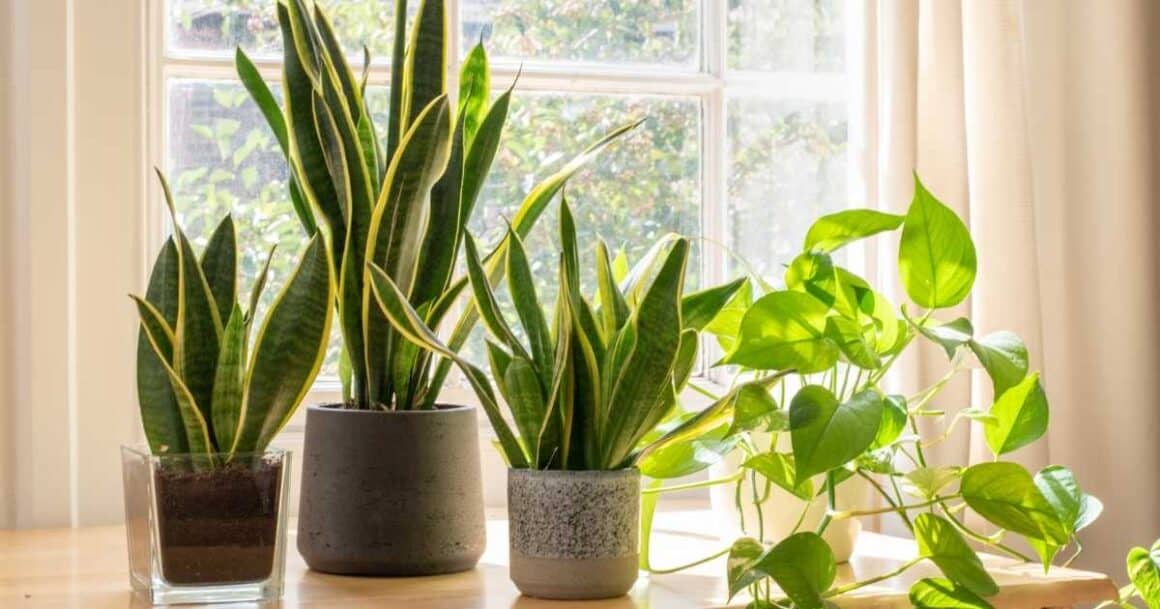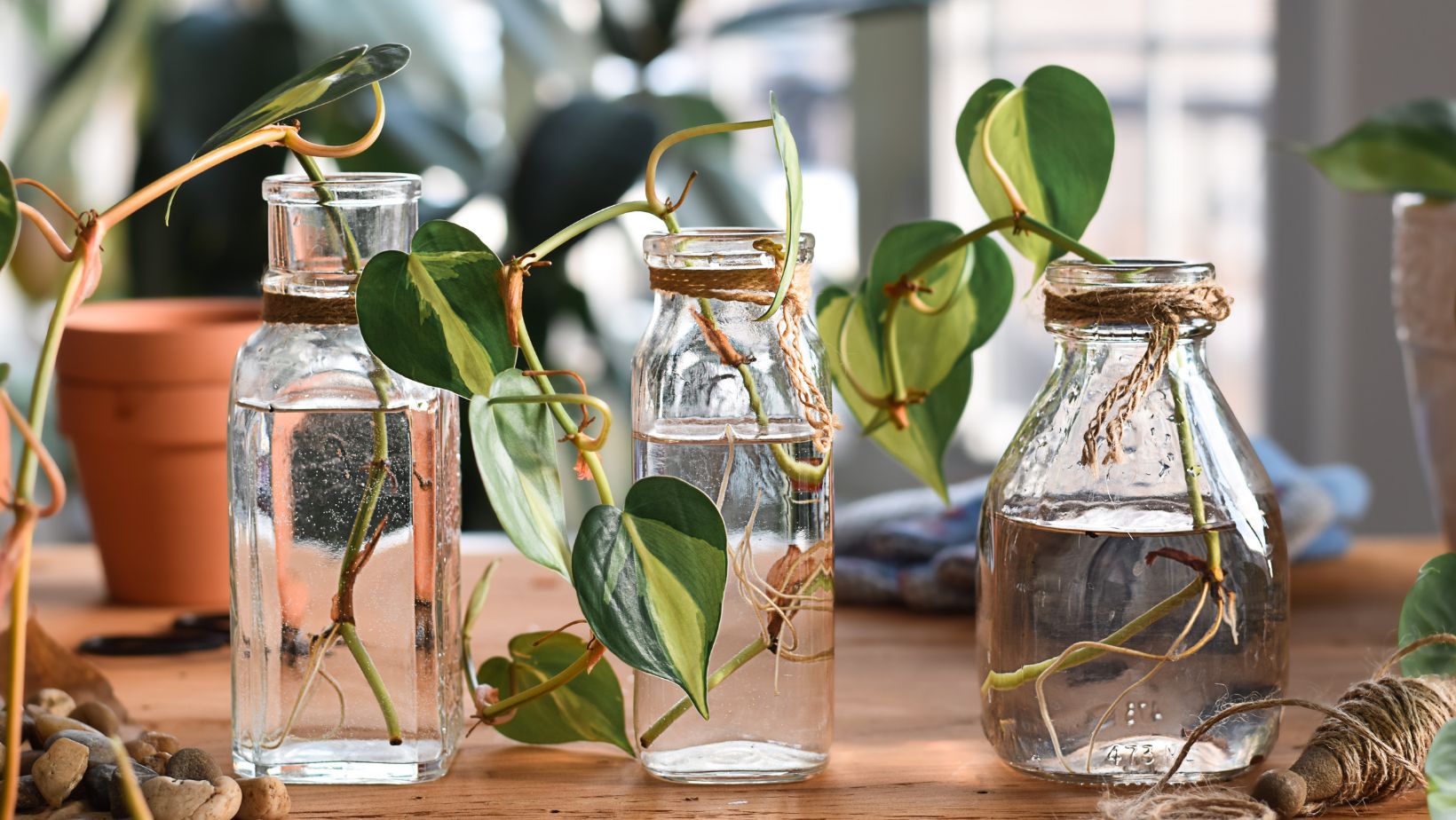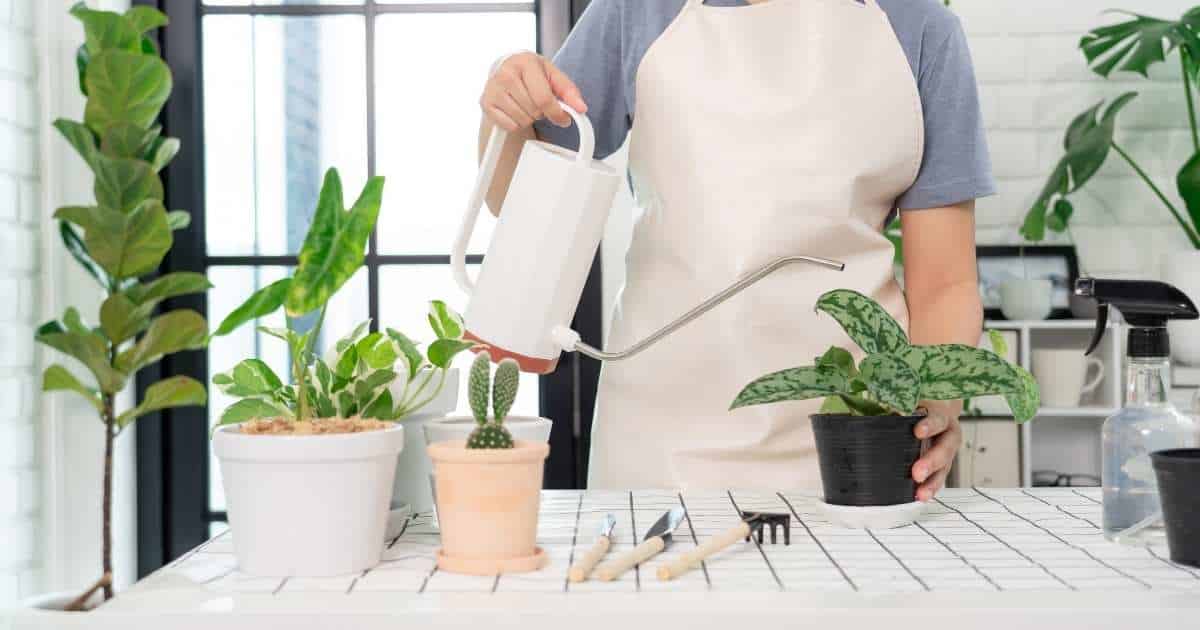10 Snake Plant Benefits for Your Home + Easy Care Tips!
In this article, the amazing snake plant benefits for your home, I am explaining all of the amazing snake plant benefits and why everyone should have snake plants in their homes!
Don’t have a green thumb!? Not to worry!
If you’re looking for a houseplant that offers plenty of benefits and is low-maintenance, then a snake plant is a perfect choice.
If you’re interested in adding a snake plant to your home or office, read on to learn everything you need to know about the benefits of snake plants and some easy care tips too!
This post may contain affiliate links. Read disclosure here

The Amazing Snake Plant Benefits for Your Home!
Snake plants are among the most popular indoor plants and for good reason!
You will be blown away by all the snake plant benefits for your home and just how easy snake plants are to care for! I know I was!
I’ve got four snake plants in my home and am currently propagating more! (more on that later!)
First things first! Let’s go over what a snake plant is, snake plant benefits, and some easy snake plant care tips as well!
What is a snake plant?
Dracaena trifasciata Common Names: Snake plant, Golden Bird’s nest, Good Luck Plant, and mother-in-law’s tongue
The snake plant or mother-in-law’s tongue is an evergreen flowering plant native to Africa.
The plant gets its common name from the shape of its leaves, which are long and narrow, like a snake’s body.
The leaves are also variegated with green and yellow stripes, giving the plant a striking appearance.
The snake plant is an easy-care houseplant that makes an excellent addition to any indoor space.
But there is more to the snake plant than meets the eye!
The Snake Plant: The Ideal Plant
Snake Plants are known for being hardy plants that can withstand a lot of neglect.
One of the reasons they’re so tough is their use of crassulacean acid metabolism.
This unique process allows them to exchange oxygen and carbon dioxide exclusively at night, preventing water from evaporating through the pores in the hot daytime sun.
Different Types of Snake Plants
There are many different types of snake plants, but some of the most popular varieties include:
Sansevieria trifasciata
This is the most common type of snake plant. It has dark green leaves with light green or yellow stripes.
Sansevieria Trifasciata ‘Laurentii’
This variety of snake plants has wider leaves than regular Trifasciata. The leaves are also a brighter green color with more pronounced yellow stripes.
Sansevieria Cylindrica
Sansevieria plants have round, tube-shaped leaves that are a blue-green color. It is a slower-growing variety and can reach up to 3 feet tall.
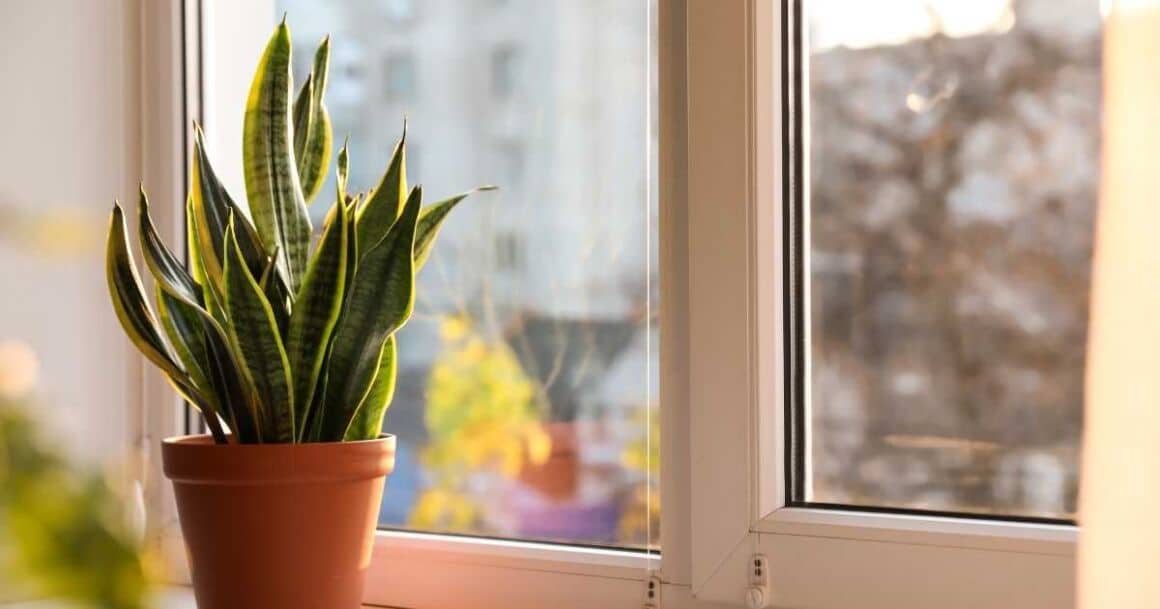
The Benefits of Snake Plants
1. Plants Promote Well-Being
There are numerous medical benefits associated with caring for plants.
When researching this article, I found endless data confirming that having plants in your home and office space and caring for the plants can improve mental and emotional health and well-being.
Further, researchers say gardening and indoor garden can help ease depression and anxiety.
2. Snake Plants can Reduce Stress Levels
A study by Japanese researchers found that plants can reduce stress and anxiety levels.
According to the researchers, adding snake plants in offices and workspaces promoted workers’ mental health. (source)
3. Snake Plants Can Increase Humidity in Your Home
Snake plants can increase the humidity in your home.
Because of the photosynthetic and respiratory processes, plants release moisture vapor, increasing the air’s humidity.
Plants release roughly 97% of the water they take in.
4. Snake Plants are Decorative
In addition to its environmental benefits, the snake plant is also stylish and versatile.
It can be used in many design styles, including contemporary, minimalist, and even bohemian.
The snake plant is versatile and stylish for any home or office.
5. Snake Plants are Low-Maintenance
One of the best things about snake plants is that they are low maintenance.
They don’t need much water or attention to thrive, so you can easily care for them even if you’re not a plant expert.
Snake plants are the perfect plant for beginners!
6. Snake Plants are Perfect for Beginners
Snake plants are easy to care for and are very forgiving when they are neglected.
7. Snake Plants are Resilient
Snake plants are tough and resilient, so they can tolerate various conditions.
Snake plants are likely to do well if you have a lot of light or low light conditions in your home.
8. Snake Plants Clean the Air!
Snake plants help to filter indoor air.
What’s unique about this particular plant is that it’s one of the few plants that can convert carbon dioxide (CO2) into oxygen at night.
This quality makes it an ideal plant for bedroom decor since it can help regulate healthy airflow.
9. Snake Plant Filter out Toxins
Snake plants are also known for their ability to help remove toxic air pollutants.
Snake plants can absorb cancer-causing pollutants, such as CO2, benzene, formaldehyde, xylene, trichloroethylene, toluene.
With the ability to absorb and remove harmful toxins, snake plants may also help against airborne allergies. (Source)
10. Snake Plants are Good Feng Shui
Snake plants aren’t your average house plants!
These decorative plants are often used in feng shui because of their many benefits.
Feng shui is the ancient Chinese art of placement and design. It is based on the belief that your environment can impact your health, wealth, and overall well-being.
Snake plants are thought to bring good luck and fortune. They are also believed to promote happiness, health, and wealth.
Snake plants are often used in feng shui because they are thought to purify the air and clear negative energy while creating a positive energy flow in your home.
If you want to use snake plants in feng shui, it is the best place to put them in the east or southeast corner of your home if possible.
Related: Need Help with your plants? There’s an app for that!
How to Care for a Snake Plant
I love snake plants! Can ya tell?!
As I’ve said, one of the benefits of snake plants is they are so super easy to grow! That said, you still need to show them a little bit of love and attention.
Here are some easy care tips for snake plants:
Place them in a bright spot
Snake plants do best in bright light and indirect sunlight.
If you don’t have much natural light in your home, don’t worry!
Snake plants are tough and can tolerant of low-light conditions. They can tolerate full sun and shady areas if you choose to have them outdoors.
Water them sparingly
Snake plants don’t need a lot of water to survive.
Allow the soil to dry out completely between watering, and don’t water more than once every two weeks. Snake plants can get root rot if overwatered.
Give them the right pot
When choosing a pot for your snake plant, ensure it has proper drainage holes to allow excess water to escape.
Snake plants don’t like to sit in wet soil, so good drainage is essential.
Keep snake plants indoors and Outdoors!
Snake plants are tolerant of a wide range of temperatures, so they can be kept indoors and outdoors.
Fertilize monthly
Snake plants don’t need to be fertilized often. Once a month is sufficient. This is the fertilizer I use for my snake plants.
Watch for pests!
Snake plants are quite susceptible to mealybugs and spider mites. For this reason, make sure you’ve got some neem oil ready!
Make new plants!
To propagate a snake plant, cut off a leaf and place it in water or moist soil. It should start to grow roots within a few weeks.
I prefer to propagate my plants in water, and I wrote an entire article about how to do it that you can find here.
Give your Snake plant a new home.
It’s best to repot snake plants every two or three years or when they become pot-bound.
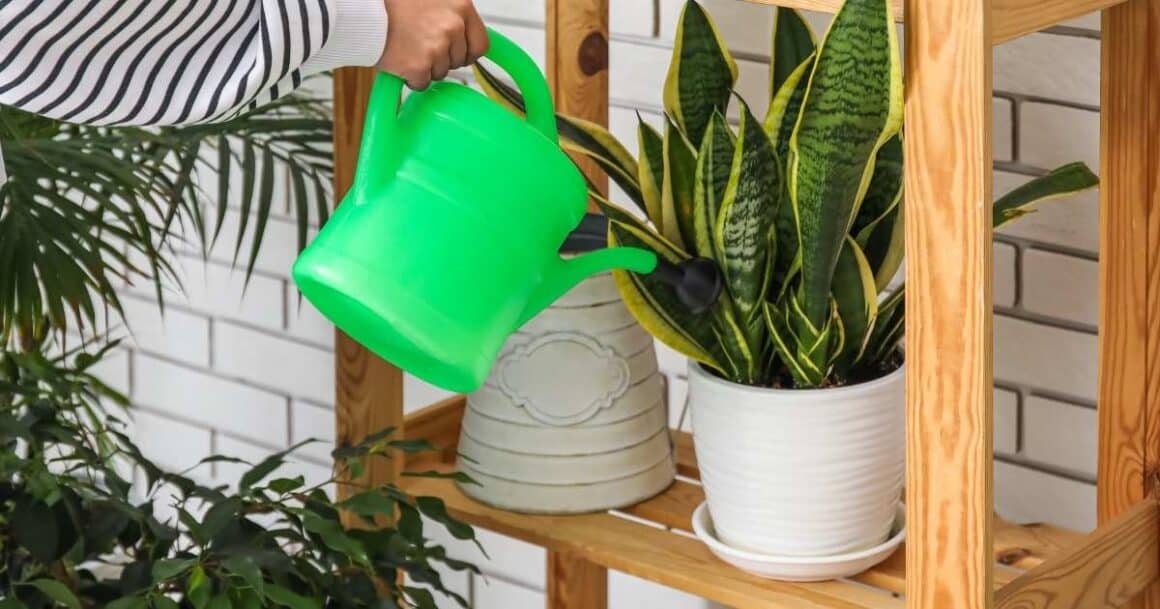
Watering Snake Plants
Snake plants prefer to have the soil dry out completely between waterings.
Water your snake plant deeply, then drain the soil before putting it back in its pot.
It’s best to use room-temperature water when watering snake plants. Cold water can shock the plant and cause leaves to drop off.
To learn more, you may want to hop over to this article about watering houseplants and the best water to use. 🙂
Snake Plants love both indoors and outdoors
Snake plants are versatile and can be placed both indoors and outdoors.
Snake plants can tolerate a wide range of temperatures and bright and low-light conditions, so they can be kept indoors and outdoors.
If you’re placing your snake plant outdoors, choose a spot that gets bright, indirect light.
Snake Plant Fertilizer + How to Fertilize a Snake Plant
The best snake plant fertilizer is a balanced, all-purpose fertilizer that can be applied once a month.
To fertilize a snake plant, mix the fertilizer with water and then pour it around the base of the plant.
Be sure to avoid getting any fertilizer on the leaves, as this can cause them to burn. Allow the soil to dry out completely between waterings.
Snake Plants and Pests
Snake plants are known to be quite resilient; they’re not indestructible, however, and are quite susceptible to mealybugs and spider mites.
These pests work by sucking the sap out of the plant, which weakens it and can cause small wounds and the shedding of leaves.
The good news is that you can do a few things to help prevent or get rid of an infestation.
I use neem oil on my plants to prevent and treat insects and diseases.
You can check out this article to learn more.
Related article: The Best Neem Oil for Plants!
Repotting a Snake Plant
It’s best to repot snake plants every two or three years or when they become pot-bound.
When repotting, choose a pot slightly larger than the current one.
Be sure to choose a pot with drainage holes to allow excess water to escape.
Snake plants prefer well-draining soil.
You can use a commercial potting mix designed for succulents or make your own by mixing equal parts sand, peat moss, and perlite.
To repot a snake plant, gently remove it from its current pot and shake off any excess soil. Place the plant in the new pot and fill in around it in with the fresh potting mix.
Water thoroughly and allow the soil to dry out completely before watering again.
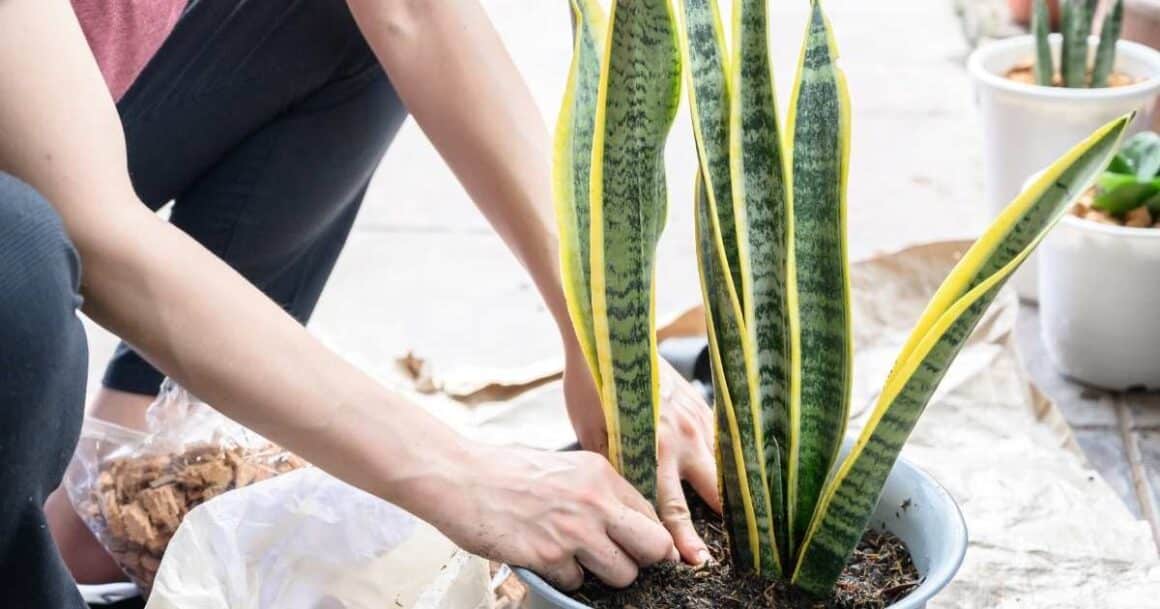
Snake Plant Propagation
1. Leaf Cuttings – One of the easiest ways to propagate a snake plant is by taking cuttings. Simply cut off a leaf and place it in water or moist soil. It should start to grow roots within a few weeks.
I prefer to use the water propagation method, which you can learn about here.
2. Division – Another easy way to propagate snake plants is by division.
You can divide snake plants when you’re repotting them.
Simply carefully pull the plant apart into two or more pieces, making sure each piece has some roots attached.
Plant the pieces in separate pots, and they should grow right away!
3. Seed – Snake plants can also be propagated from seed, but this method is more difficult and takes longer and I have never tried to propagate a snake plant from seed.
Not to worry! If you are interested in this propagating method, hop over to this article: How to propagate a snake plant from seed to learn more!
No matter which method you choose, snake plant propagation is relatively easy.
With a little patience, you can soon have snake plants growing all over your home.
Are Snake Plants Toxic to Pets?
In a word, yes.
While snake plants are lovely, one of the most common complaints about snake plants is that they can be poisonous to pets.
If your dog or cat ingests your snake plant, it can cause vomiting, diarrhea, and even liver damage.
Snake Plant Problems: Snake Plant Disadvantages
As you’ve read so far, snake plants have many benefits. However, there are a few disadvantages to snake plants that potential owners should be aware of.
Snake plants can be toxic to pets.
One of the most common complaints about snake plants is that they can poison pets.
If ingested, the leaves of a snake plant can cause vomiting, diarrhea, and difficulty breathing in dogs and cats.
Snake plants are allelopathic.
I read somewhere that snake plants are known to be allelopathic, which means that they release chemicals that can inhibit the growth of other nearby plants.
As a result, it is important to exercise caution when planting snake plants near other vegetation.
The thing is, I can’t remember where the heck I read this! So, I did a bit of research to double-check.
Turns out, there isn’t a lot of data I wouldn’t give it a second thought. 🙂
Snake plants are sharp.
Finally, some people find the sharp, sword-like leaves of snake plants to be unappealing, they can also be off-putting to some people.
Snake plants make a great addition to any home or office, but you should be aware of their potential drawbacks before purchasing.
Snake plants are slow growing.
The snake plant is a slow-growing plant, which means it can take a while to reach its full size. For that reason, if you want a large snake plant, buy it large. 🙂
The bottom line, the benefits of snake plants far outweigh the few problems snake plants may have.
Conclusion: Snake Plant Benefits and Easy Care Tips:
If you’re looking for an easy-to-care-for plant with many benefits, look no further than the snake plant.
Snake plants are the ideal choice for any home or office space!
Snake plants tolerate many conditions, making them ideal for indoor and outdoor spaces.
So why not give snake plants a try? You might just be surprised at how much you love them.
If you have any snake plant tips of your own or if you have any questions. And don’t forget to share this article with your friends and family if you found it helpful!
Thanks for reading!
XO, Christine

I’ve been keeping it real since 1963. 🙂
I’m a child of God, a wifey, mama, grandma, full-time creative, domestic engineer, and self-care enthusiast.
I am obsessed with all things makeup and skincare and love getting my hands dirty out in the garden, my art room, or in the kitchen, whipping up something yummy for the fam.
I’m always down to chat and love collaborating with other creatives and brands alike!
Feel free to reach out anytime!
